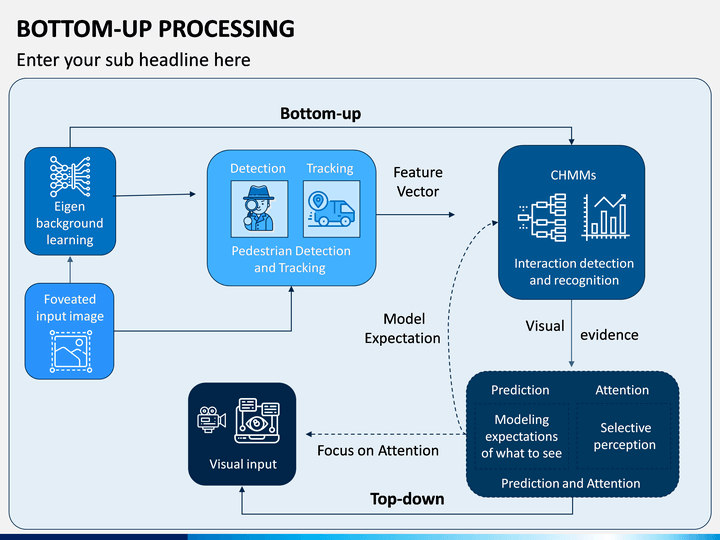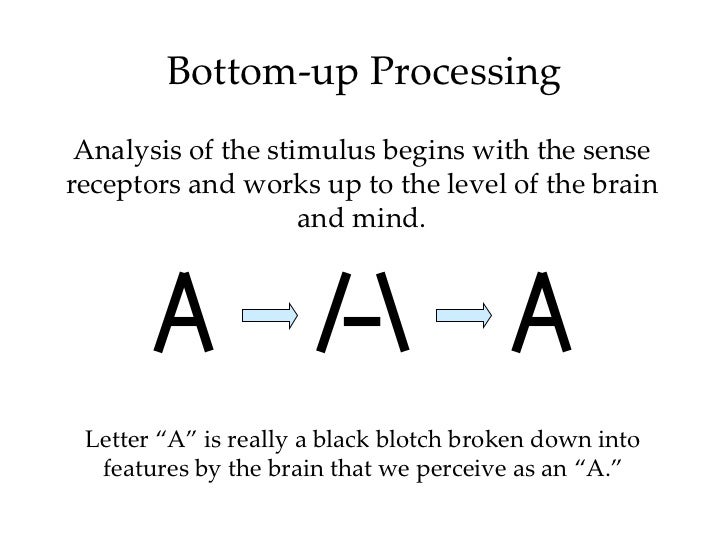

BOTTOM UP PROCESSING EXAMPLE SOFTWARE
In the software development process, the top-down and bottom-up approaches play a key role. įor perspective, for a product with more restrictive requirements (such as weight, geometry, safety, environment, etc.), such as a space-suit, a more top-down approach is taken and almost everything is custom designed.Ĭomputer science Software development Part of this section is from the Perl Design Patterns Book. In a top-down approach, a custom fastener would be designed such that it would fit properly in the receiving components. An example would include selecting a particular fastener, such as a bolt, and designing the receiving components such that the fastener will fit properly. The bottom-up approach is being utilized when off-the-shelf or existing components are selected and integrated into the product. However, "organic strategies" may result in a tangle of elements and subsystems, developed in isolation and subject to local optimization as opposed to meeting a global purpose.ĭuring the design and development of new products, designers and engineers rely on both a bottom-up and top-down approach. This strategy often resembles a "seed" model, by which the beginnings are small but eventually grow in complexity and completeness. These elements are then linked together to form larger subsystems, which then in turn are linked, sometimes in many levels, until a complete top-level system is formed. In a bottom-up approach the individual base elements of the system are first specified in great detail. From a cognitive psychology perspective, information enters the eyes in one direction (sensory input, or the "bottom"), and is then turned into an image by the brain that can be interpreted and recognized as a perception (output that is "built up" from processing to final cognition).

Bottom-up processing is a type of information processing based on incoming data from the environment to form a perception. Ī bottom-up approach is the piecing together of systems to give rise to more complex systems, thus making the original systems sub-systems of the emergent system. Top down approach starts with the big picture, then breaks down from there into smaller segments. However, black boxes may fail to clarify elementary mechanisms or be detailed enough to realistically validate the model. A top-down model is often specified with the assistance of "black boxes", which makes it easier to manipulate. Each subsystem is then refined in yet greater detail, sometimes in many additional subsystem levels, until the entire specification is reduced to base elements. In a top-down approach an overview of the system is formulated, specifying, but not detailing, any first-level subsystems. Make decisions about reusable low-level utilities then decide how they will be put together to create high-level construct.Ī top-down approach (also known as stepwise design and stepwise refinement and in some cases used as a synonym of decomposition) is essentially the breaking down of a system to gain insight into its compositional sub-systems in a reverse engineering fashion. Object-oriented languages such as C++ or Java uses a bottom-up approach where each object is identified first.

The parts are linked to form larger components, which are in turn linked until a complete system is formed.

In this design, individual parts of the system are specified in detail. Then break the parts into parts soon and now each of parts will be easy to do.īreaking problems into parts help us to identify what needs to be done.Īt each step of refinement, new parts will become less complex and therefore easier to solve.īreaking problems into parts allows more than one person to solve the problem. For example: Writing a University system program, writing a word processor. Each part of it then refined into more details, defining it in yet more details until the entire specification is detailed enough to validate the model. In the top-down model, an overview of the system is formulated without going into detail for any part of it. In practice, they can be seen as a style of thinking, teaching, or leadership. Top-down and bottom-up are both strategies of information processing and knowledge ordering, used in a variety of fields including software, humanistic and scientific theories (see systemics), and management and organization. ( Learn how and when to remove this template message) This article may need to be rewritten to comply with Wikipedia's quality standards.


 0 kommentar(er)
0 kommentar(er)
